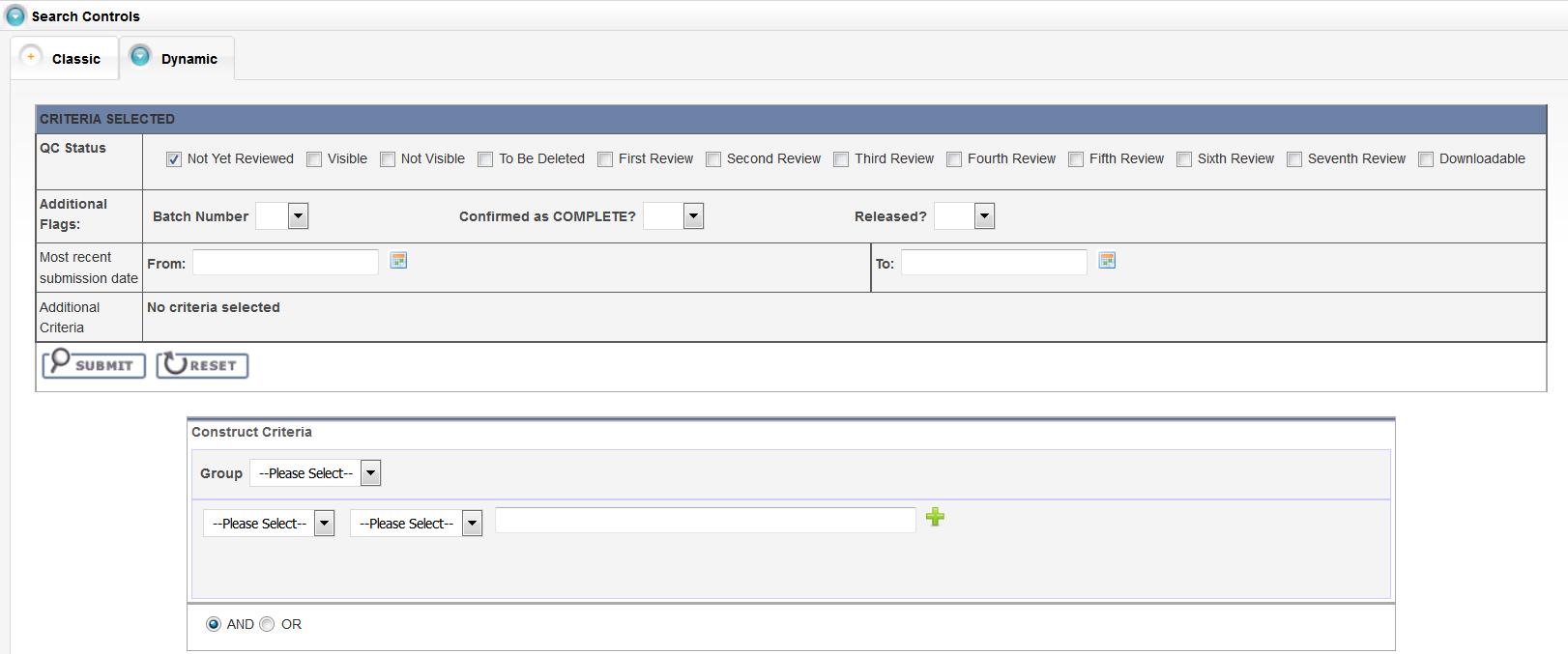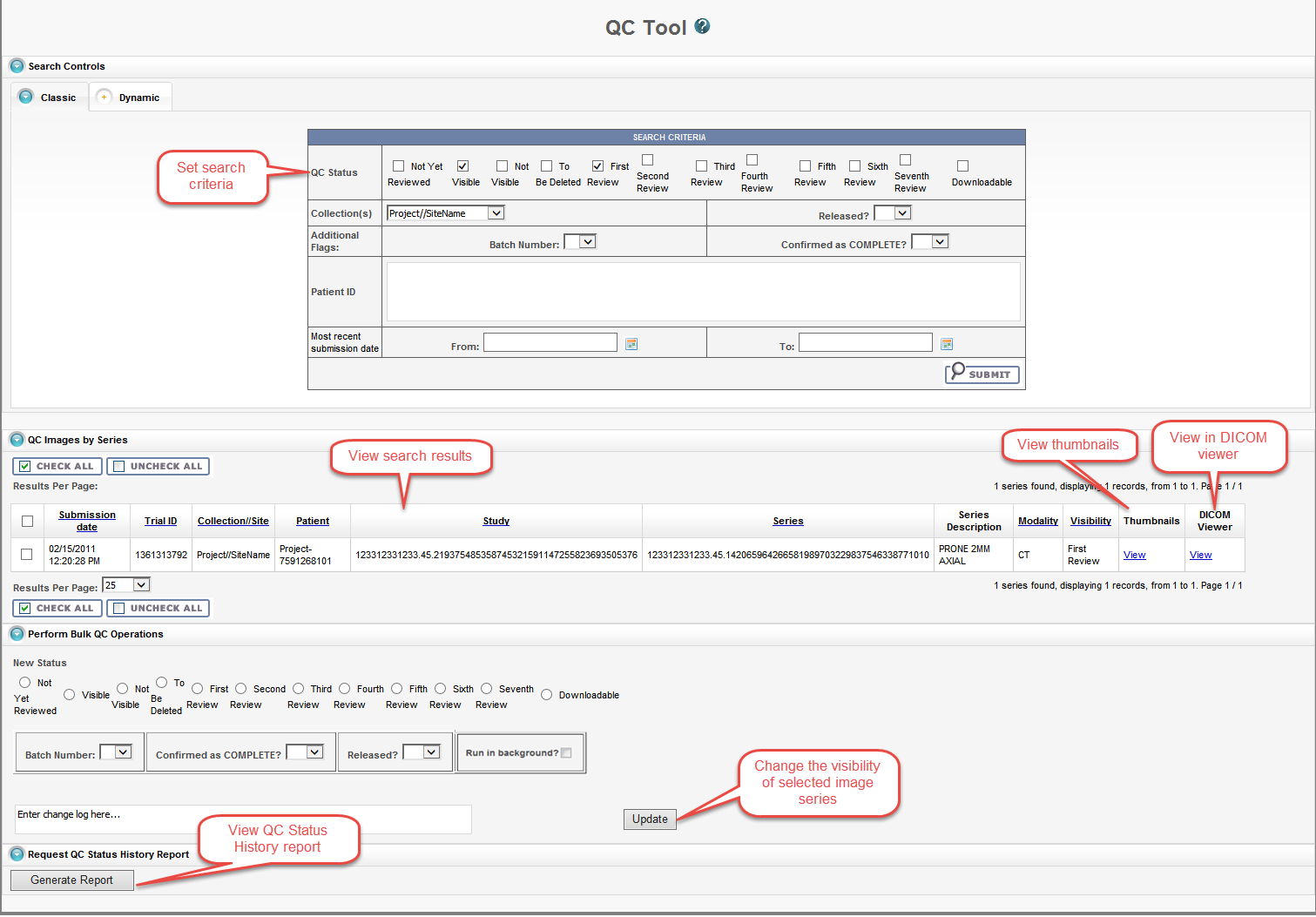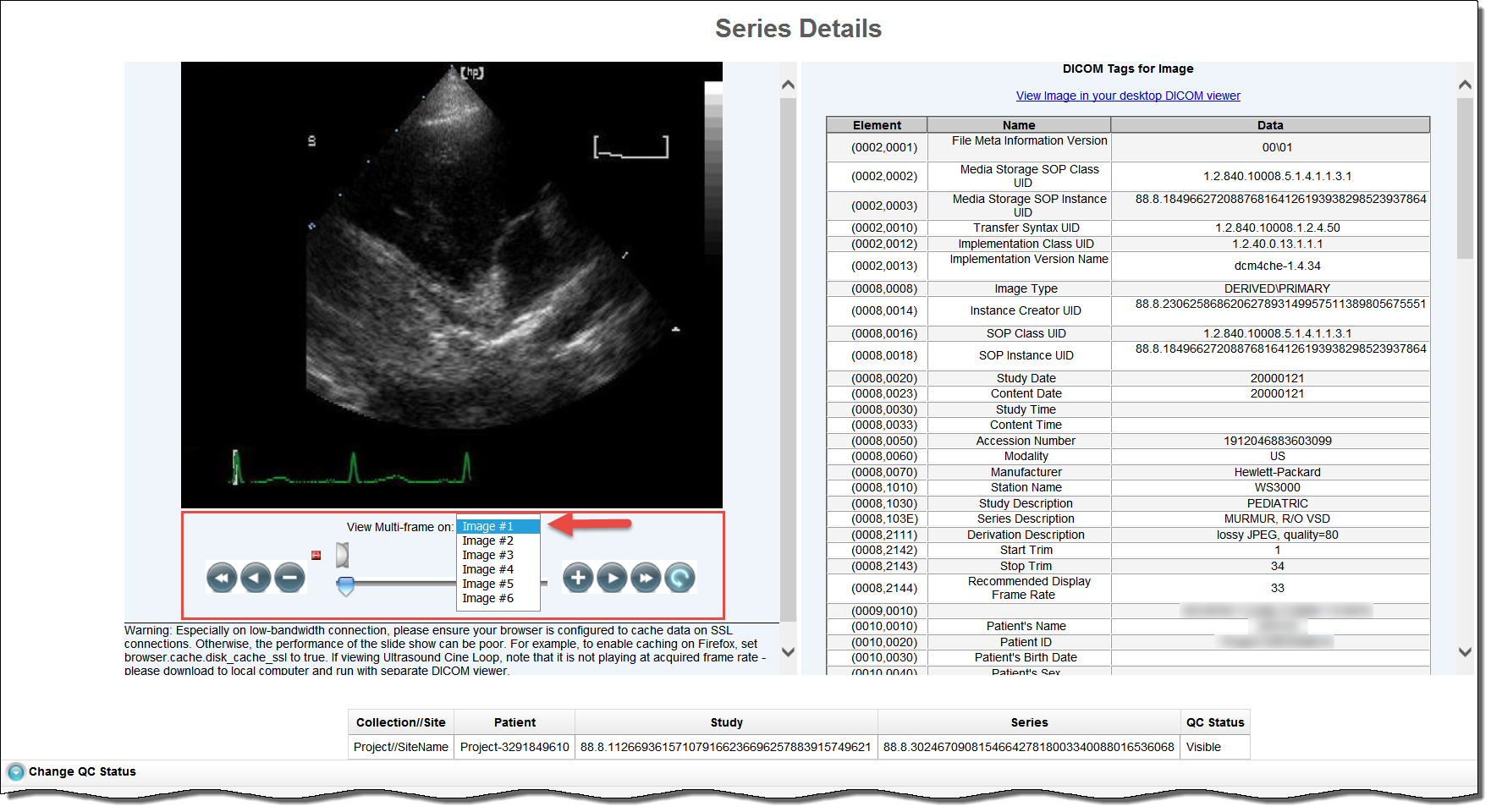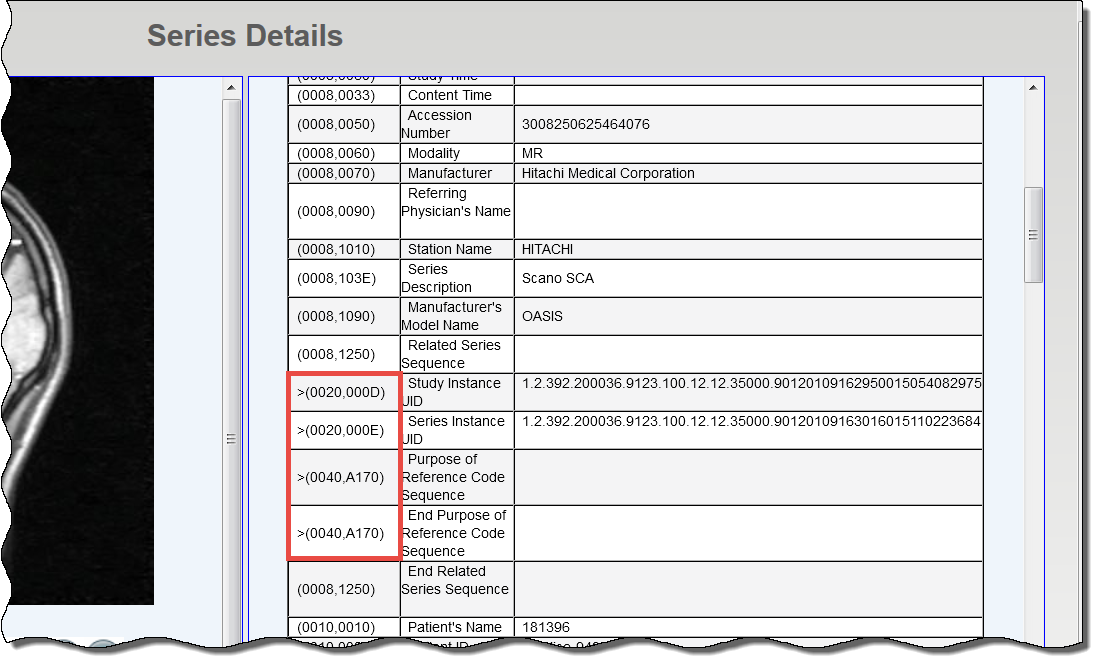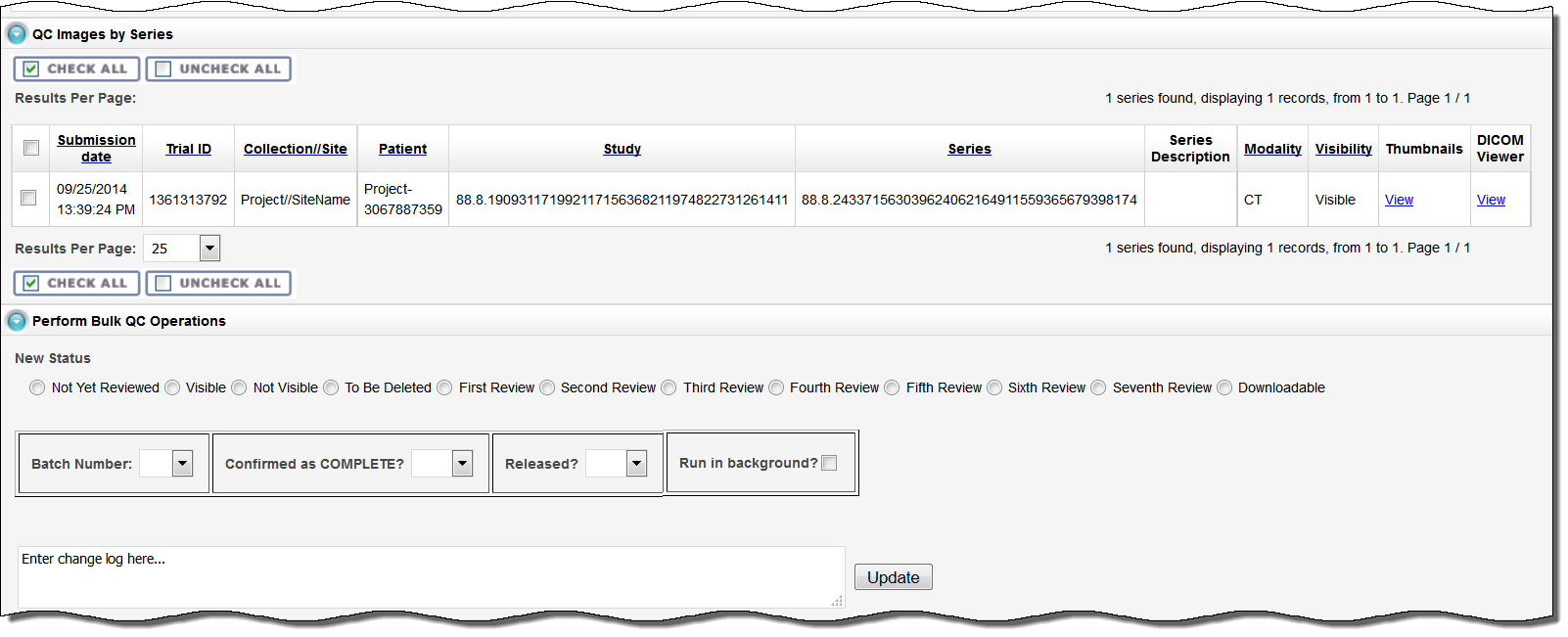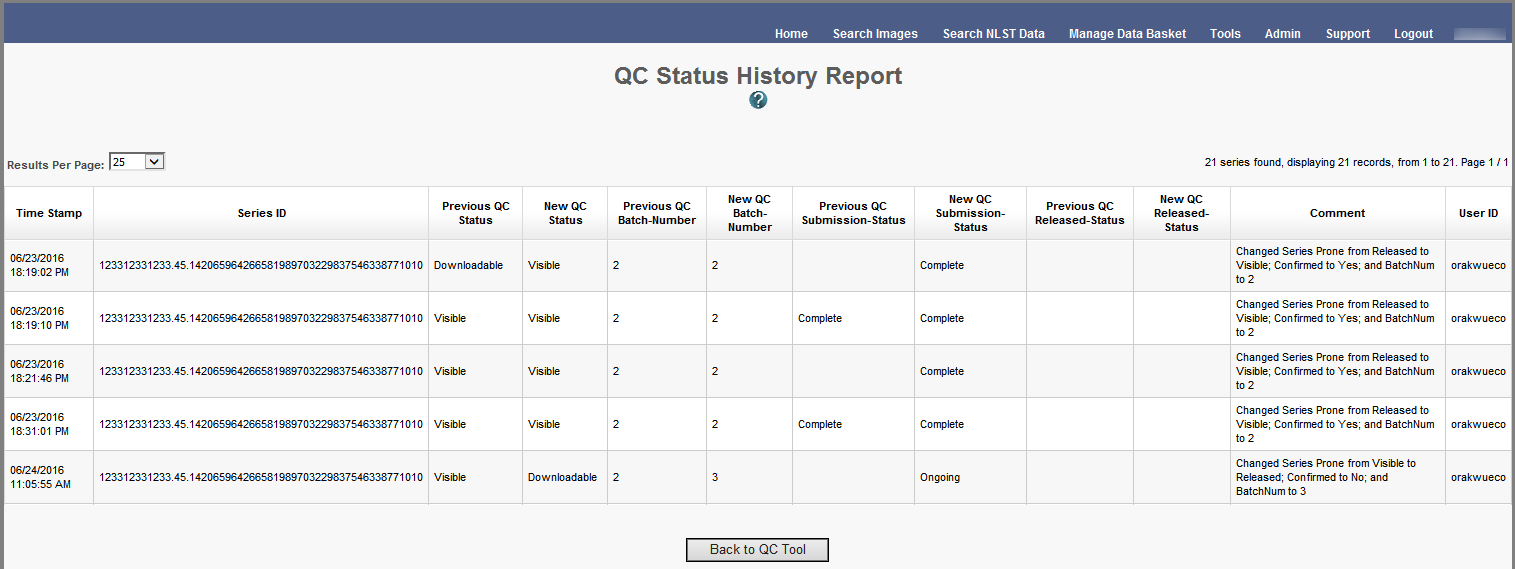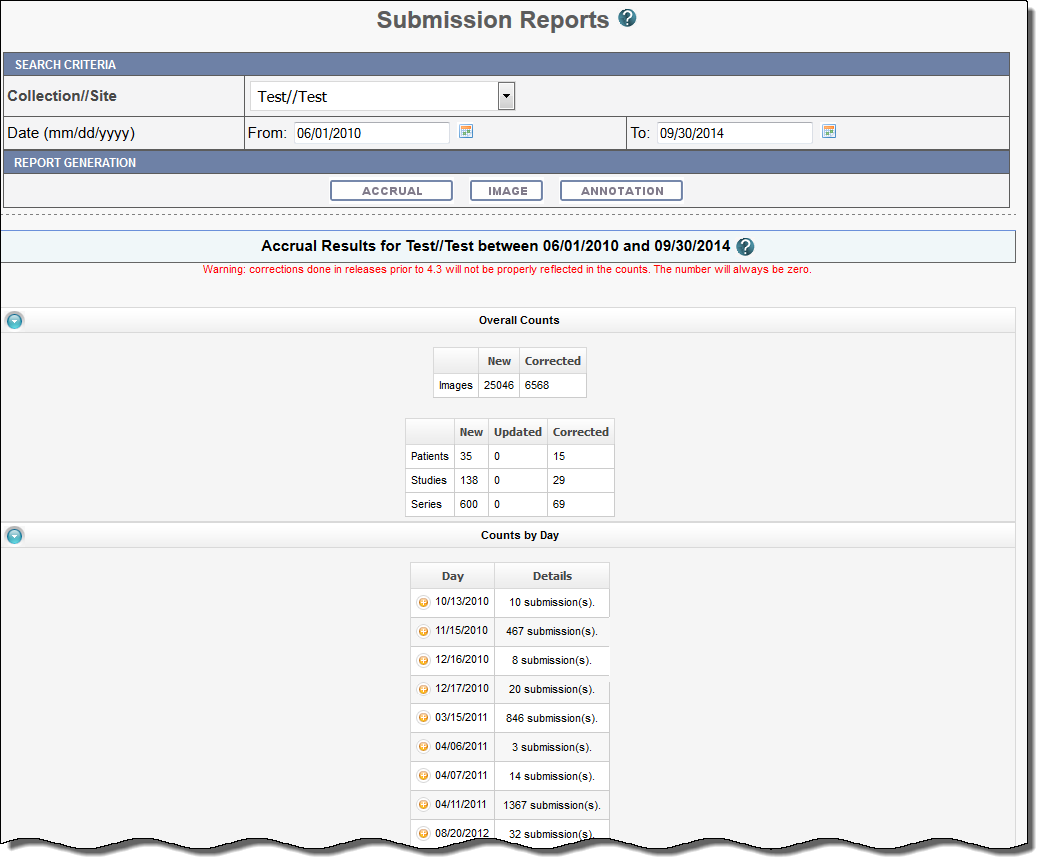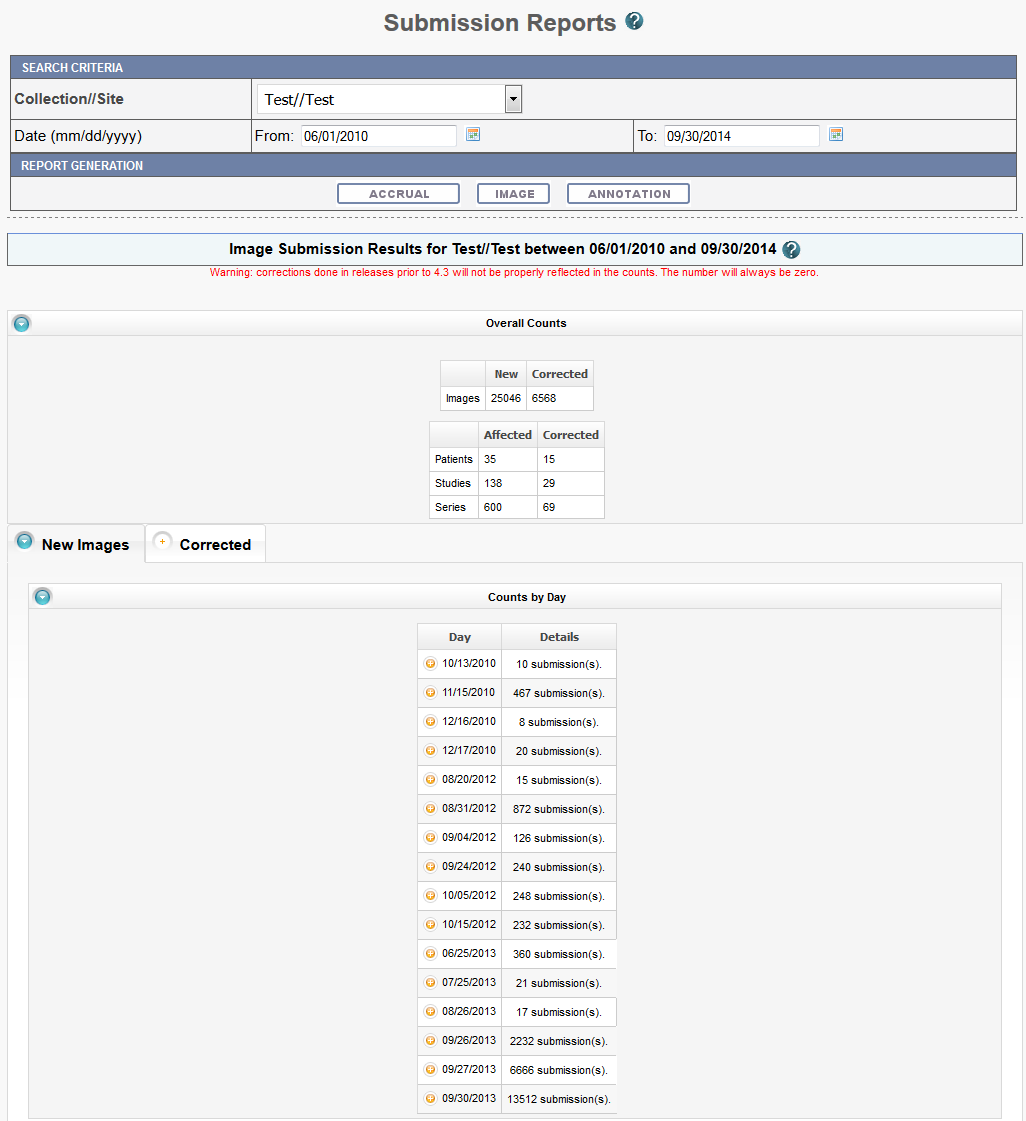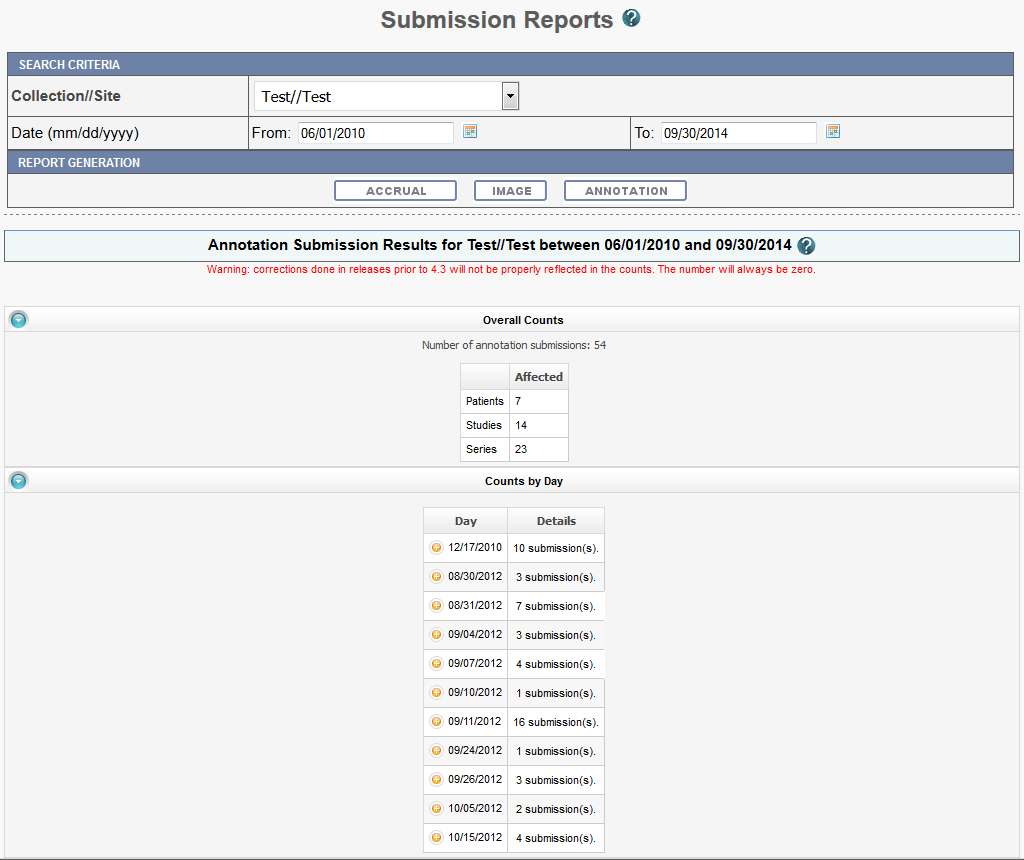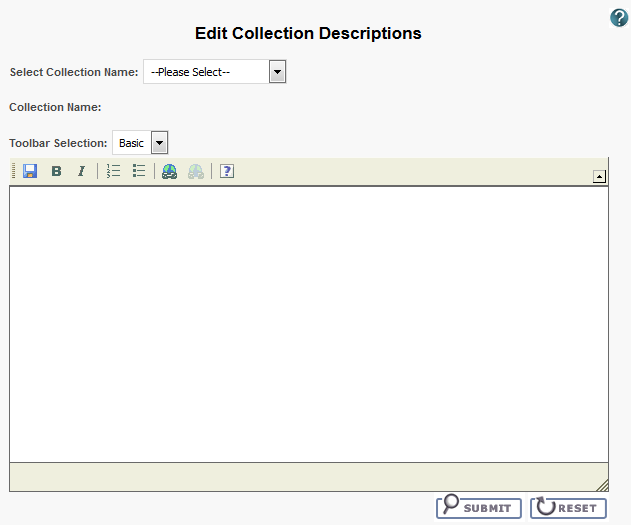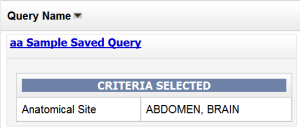This guide explains how to use the administrative features of the National Biomedical Imaging Archive (NBIA).
Administration Functions Overview
Security applies to all administration tools in NBIA. When you log into NBIA, only the administration tools for which you have been granted permissions are visible in the Admin menu. Their use is described on this page.
Creating a New NBIA User
Only an NBIA administrator can create new users for NBIA.
Before NBIA users can be created, an administrator with access to the User Authorization Tool must register the NCIA application and assign an administrative user to the NCIA application there. The administrator can then assign users to NBIA and roles to each user. The following table describes the role structure in NBIA.
Role | Functionality | Can Perform Operation |
|---|---|---|
NCIA.READ | Search capability | Everything else Note: This role is applied to guest users. |
NCIA.MANAGE_VISIBILITY_STATUS | Access the QC Tool | |
NCIA.VIEW_SUBMISSION_REPORT | Access and verify a submission | |
NCIA.MANAGE_COLLECTION_DESCRIPTION | Edit a collection description | |
NCIA.SUPER_CURATOR | Create, edit, and delete workflow items Review and delete saved queries Approve the deletion of image series Delete a shared list | |
NCIA.DELETE_ADMIN | Delete images approved for deletion | |
| NCIA.ADMIN | Use the User Authorization Tool | Use the User Authorization Tool Note: This role is also needed to access CSM UPT. |
The roles you assign allow a user to perform tasks in NBIA. Additionally, an administrator can perform the following tasks:
- Assign a user the privilege to use the QC tool for the purpose of reviewing submitted imaging data and managing visibility status for the data. See Using the Quality Control Tool.
- Verify submitted files. This includes the permission to view the image submission report which includes submission statistics and information regarding what has been received by the image repositories. See Viewing Submission Reports.
- Configure security for data submitted to NBIA.
Do not use special characters in user names. You can use special characters in passwords.
For more information about creating new NBIA users/user groups and performing other tasks in the User Authorization Tool, see the User Authorization Tool documentation.
Using the QC Tool
For more information about roles, see Creating a New NBIA User.
When an image is uploaded to NBIA, it is not made public immediately. A curator takes it through a quality control process to ensure that no private patient data is available, the image is of good quality, and so forth. Using the QC tool as a curator, you can define search criteria to locate image series for you to evaluate. You can then evaluate the submission and assign the QC status to an image or image series.
QC tool search visibility
The QC tool allows a curator to search "non-visible" or "not reviewed" images, whereas a regular user using the search tool can only see approved public images.
Topics in this section:
Classic Search
To perform a classic search
Click Admin > Perform QC. This opens the QC Tool page to the Classic tab, shown below. You can specify basic search criteria on this tab. You can construct more specific search criteria on the Dynamic tab.
Do not click your browser's Back or Refresh button while following these steps. This logs you out.
Check the QC Status for the series you want to locate. The options are described in the following table:
Submitted Object Status
Description
Not Visible No images in the series are visible. Not Yet Reviewed
This status (selected by default) is automatically assigned to an image upon submission to the NBIA database.
First Review to Seventh A configurable user-defined stage in the workflow of an image series. To Be Deleted
Selected image series are to be deleted from the system.
Visible All images in the series are visible. Downloadable Test the visibility of images in the series. This allows for downloading when set. It also separates the test cases from released cases. In the Collection(s) field, select one collection (site) that you want to search. You cannot search multiple collections (sites) at one time.
- In the Batch Number field, select the batch number of the images/series for which you want to search. You can also select Any, to find all batches that have a batch number, or None, to find all batches that do not have a batch number.
- In the Confirmed as COMPLETE field, select Yes to search for a set of images/series that has been confirmed as complete, or No to search for a set of images/series that is ongoing.
In the Released field, select Yes to search for images/series that have been released or No to search for images/series that have not been released.
To restrict results to a list of patient IDs, in the Patient ID panel, enter the list of patient IDs and select Add Criteria to perform the search. Separate multiple patient IDs with commas.
In the From and To boxes, enter the most recent series submission date range by selecting a date in the calendar or by using the format mm/dd/yyyy.
- Click Submit. NBIA searches for image series that match the criteria you define.
See also Understanding QC Tool Search Results.
Dynamic Search
To perform a dynamic search
Click Admin > Perform QC. Select the Dynamic tab, shown in the following figure. The Dynamic tab allows you to construct specific search criteria.
Do not use the back button nor the refresh button in these steps, either of which will return the page back to the previous page.
Check the QC Status for the series you want to locate. The status options are described in the following table.
QC Status
Description
Not Visible No images in the series are visible. Not Yet Reviewed
This status (selected by default) is automatically assigned to an image upon submission to the NBIA database.
First Review to Seventh A configurable user-defined stage in the workflow of an image series. To Be Deleted Selected image series are to be deleted from the system. Visible
All images in the series are visible.
Downloadable Test the visibility of images in the series. This allows for downloading when set. It also separates the test cases from released cases. - In the Batch Number field, select the batch number of the images/series for which you want to search. You can also select Any, to find all batches that have a batch number, or None, to find all batches that do not have a batch number.
- In the Confirmed as COMPLETE field, select Yes to search for a set of images/series that has been confirmed as complete, or No to search for a set of images/series that is ongoing.
- In the Released field, select Yes to search for images/series that have been released or No to search for images/series that have not been released.
- In the From and To boxes, enter the most recent submission date range by selecting a date in the calendar or by using the format mm/dd/yyyy.
- For each criterion you select, click the green (+) symbol. This confirms the selection and displays the criterion above the first Submit button.
- To select more criteria, do so in the Construct Criteria section. Options under the drop-down arrows change according to the group you select. You can also specify the Boolean
ANDorORto express relationships among criteria. - Click Submit. NBIA searches for image series that match the criteria you define.
See also Understanding QC Tool Search Results.
Understanding QC Tool Search Results
After you submit search criteria in the QC tool, you can do the following on the search results page.
- View the image series meeting your search criteria.
- Assign a new status to one or more image series in your search results.
- Generate a QC Status History report.
Viewing Image Series
Your search results appear in a table in the QC Images by Series section of the QC Tool page.
In addition to viewing image series details in the table, you can view them as thumbnails or in the DICOM viewer.
Viewing Thumbnails
In the Thumbnails column, click View to see image series details.
The Series Details page appears, displaying the first image in the series on the left and the DICOM tags for the image on the right. If there is more than one image in the series and DICOM tags for each image, you can view an animated slideshow of the images in the series. For more information about the controls in the animated slideshow, see Viewing Image Animation. The DICOM tags change when you view a different image in the series.
If the image series modality is Ultrasound, you can view each image in the series in multi-frame, as shown below. You can move to other images in the series by selecting them from the drop-down list.
If the collection you selected for viewing includes sequence information, the annotations show the sequence data identified by a (>) to the left of the Element column, as shown below.
Viewing Image Series in the DICOM Viewer
In the DICOM Viewer column, click View to open the image series in the Oviyam DICOM viewer. For more information, see QC Tool Search Results.
Changing Image Series Status
As a curator, you may need to change the status of one or more images or image series. You can change the status of one or more selected images or image series individually or as a batch update.
Before you can change the status of an image or image series, you must use the QC Tool to find it. You must then select the image or image series you want to change.
Status options include:
QC Status | Description |
|---|---|
Not Yet Reviewed | This status (selected by default) is automatically assigned to an image upon submission to the NBIA database. |
Visible | All images in the series are visible. |
Not Visible | No images in the series are visible. |
To Be Deleted | Selected image series are to be deleted from the system. |
| First Review to Seventh | A configurable user-defined stage in the workflow of an image series. |
| Downloadable | Test the visibility of images in the series. This allows for downloading when set. It also separates the test cases from released cases. |
If you change the status of an image series, the change is also reflected in any shared lists to which the image series belongs. If you attempt to change the status of an image series that is in a shared list, an alert message appears, detailing to which shared lists the selected image series belong(s).
To change image series status
- Select Admin > Perform QC. The QC Tool page appears.
Scroll down to the QC Images by Series section. The images you selected in the Classic search or Dynamic search appear in the table. - Select the image(s) or series for which you want to change the status.
- To select a single image in a series, click View in the Thumbnails column, then use the cine tool to locate the image you want to change.
- To select a single series, select the box in the search results table corresponding to the image series you want to change.
For a bulk update, select multiple image series in the search results table or click Check All, which is above and below the search results table.
Selecting images to QC
The Check All and Uncheck All buttons in the QC Images by Series section of the QC Tool page apply to all of the results of your search. The box to the left of the Submission Date column only selects the series in that row of the results table.
In the Perform Bulk QC Operations section, select the new status you want to assign to the selected image or series. If you are applying the status change to many collections at once, click Run in background to run the bulk operation in a separate thread, improving system performance.
In the Change Log box, describe the nature of the image status change. This text will be part of the QC Status report you can generate to track changes in visibility. See Generating a QC Status Report.
Click Update to update the selected image(s) or series.
After the image series' status has been changed, the status column of the image series in the search results table on the QC Tool page also changes.
Generating a QC Status History Report
The QC Status History Report appears, displaying all changes that have been made to the status of the series you selected.
Click Back to QC Tool to close this window and return to the QC tool.
Deleting Image Series
As an administrator, you can assist in the two-tier process of deleting NBIA data. To do so, you must have been granted specific roles. For more information about the roles and the deletion processes, see Approving Image Deletions and Manually Deleting Image Series.
Approving Image Deletions
For more information about roles, see Creating a New NBIA User.
This function is part of a two-tier deletion process. A super curator can approve the deletion of image series that have been identified as "To be deleted".
To approve series deletions, follow these steps:
- Click Admin > Approve Deletions.
The Approve Deletions page appears. - From the Collection(s) list, select a collection (site).
- Optionally, enter Patient IDs. Separate multiple IDs by commas.
- Click Submit to initiate a search for the series marked for deletion.
From the results, click View to review the detail for an individual series. From the page that opens, click Delete to approve the deletion. Click the Skip button to go to the next series.
Tip
If you click Skip, this signals that you do not approve the deletion. If that is so, you should generate a report to see who requested the deletion and work with that person to resolve any deletion disagreement.
- For batch deletion, select the checkbox for one or more series and click Delete to approve the deletion.
Image series approved for deletion are still visible in the system, identified as "To Be Deleted". They are removed from the system at a system-configured time, such as at midnight (called an "off-line deletion"), unless a manual deletion (called an "online deletion") is performed. For more information, see Manually Deleting Image Series.
About deletions
- After an image series is approved for deletion, the action cannot be reversed.
- Any new image submissions to a series identified "To be deleted" will be successful, but the status of the series does not change.
- Images submitted to files that are identified as "Deleted" are quarantined.
Manually Deleting Image Series
For more information about roles, see Creating a New NBIA User.
This function is part of a two-tier deletion process. You can execute the online deletion of image series that are approved for deletion. This immediately removes images that are approved for deletion rather than requiring you to wait for the next scheduled system-wide deletion job.
To manually delete series, follow these steps:
- Click Admin > Perform Online Deletion.
A list of image series that have been approved for deletion appears. Click Delete to execute the real-time series removal.
Deleting individual series?
All series listed in this page are deleted. There is no way to specify individual series for online deletion.
Viewing Submission Reports
For more information about roles, see Creating a New NBIA User.
When a site submits images to NBIA, a user with admin privileges can run various reports to verify that the images have been received and to monitor the status of the submitted images. This is accomplished in NBIA by generating a report with this information.
To view submission reports, follow these steps:
- Click Admin > View Submission Reports.
The Submission Reports page appears.
The Collection//Site section displays all collections for which you, as an Admin, have permissions to view. - Select a collection.
- Enter a valid date range or select one by clicking the calendar icons.
- Click the report type you want to run: Accrual, Image, or Annotation.
The search begins and may take a few moments.
To assist in viewing the reports, use the following icons:
- In the report results in the upper right segment of the page, click the Help button () to learn details about the report type you selected.
- Click the arrow at the left of the section to hide () or show () the results.
- To view an expanded view of the image report results, click the Expand icon () preceding each row of the New Image or Corrected summaries.
The results display Count by Day details of the submissions. For example, for each day in the time frame, you can view a list of affected patient IDs, study instance UIDs and series instance UIDs.
Accrual Report
Fields that appear on the report are described in the following table.
Submitted Files Counts Fields | Description |
|---|---|
New Image | An image that does not exist in the system at the time of submission |
Corrected Image | An Image that has been successfully submitted more than once. The time of the original image submission does not affect whether a subsequent image is considered as "corrected". Each time, an image is re-submitted in the time frame, the count is incremented. |
New Patient | A patient that had no images submissions prior to the start of the date range, but at least one image submission within the date range |
Updated Patient | A patient that had at least one image submission prior to the start of the date range, and at least one image submission within the date range |
Corrected Patient | A patient that has at least one image submission in the time frame that has been corrected. |
New Study | A study that had no image submissions prior to the start of the date range, but has at least one image submission within the date range |
Updated Study | A study that had at least one image submission prior to the start of the date range, and at least one image submission within the date range |
Corrected Study | A study that has at least one image submission in the time frame that has been corrected. |
New Series | A series that no image submissions prior to the start of the date range, but has at least one image submission within the date range |
Updated Series | A series that had at least one image submission prior to the start of the date range, and at least one image submission within the date range |
Corrected Series | A series that has at least one image submission in the time frame that has been corrected |
Report content
The reports contain a count of patient/study, series or images that have been affected during the date range in the specified collection/site.
Image Submission Report
Image submission results display a count of patients, studies or series for or to which an image was submitted during the specified date range in the collection or site you selected. Fields that appear on the report are described in the following table.
Submitted Files Counts Fields | Description |
|---|---|
New Image | An image that does not exist in the system at the time of submission |
Corrected Image | An Image that has been successfully submitted more than once. The time of the original image submission does not affect whether a subsequent image is considered as "corrected". Each time, an image is re-submitted in the time frame, the count is incremented |
Affected Patient/Study/Series | A patient/study/series is one for which there was at least one new image submission |
Corrected Patient/Study/Series | A patient/study/series that has at least one image submission that has been corrected in the time frame. |
Report content
The reports contain a count of patient/study, series or images that have been affected during the date range in the specified collection/site.
Annotation Submission Report
The annotation submission report contains a count of annotations submitted and affected patient/study/series during the specified date range for that collection site. Fields that appear on the report are described in the following table.
Submitted Files Counts Fields | Description |
|---|---|
Annotation | An annotation that has never been submitted in the system prior to the start of the date range |
Corrected Image | A patient/study/series is one for which there was at least one new annotation submission |
Report content
The reports contain a count of patient/study, series or images that have been affected during the date range in the specified collection/site.
Editing a Collection Description
For more information about roles, see Creating a New NBIA User.
This feature allows you as an administrator to enter a brief description for a collection so the NBIA user knows what type of data comprises the collection.
To edit a collection description, follow these steps:
- Click Admin > Edit Collection Description.
The Edit Collection Descriptions page appears. - From the Select Collection Name list, select a collection name.
- In the text box, enter a description or edit an existing description for the collection. Use the text formatting tools to format the text, if you like. If appropriate, you can add a hyperlink to a resource such as a wiki with a longer description.
The description displays on the simple/advanced search screen when you click the (?) button next to the collection name.
Creating a clickable link
To make a link clickable in this section, select Rich for Toolbar Selection, select Source (), and create a link as shown in the following example:
<span contenteditable="false"><a href="https://www.google.com" target="_blank"><span>Link To Be Created</span> </a></span></p>
If you want to edit the link, select the Source button and set contenteditable to true.
Managing Workflow Items
For more information about roles, see Creating a New NBIA User.
A workflow is a business process that, in the case of NBIA, an image series must pass through before it is published. Since it is a business process, these steps must be defined first within an organization. NBIA allows you to change the visibility status of an image series. This visibility change is part of the definition of a workflow item. Workflow items can also trigger a web service call to a URL. When you define a workflow item, you specify a name for it, the type of action that will take place during it (such as a visibility change), which image collection and site are involved, and the URL of a web service if the information resulting from this workflow item should be sent to one.
You can create, edit, and delete workflow items
Creating a Workflow Item
- Select Admin > Manage Workflow Items.
The Manage Workflow Items page appears. - Click Create Workflow.
The Workflow Item page appears. In the Name box, specify a name for the new workflow item. The name cannot be longer than 50 characters.
From the Type list, select Visibility Change or New Series.
Select the Visibility Change option when editing an existing workflow item. A visibility change occurs when the workflow item triggers a web service call to the URL you have entered in the URL field on this page.
Select the New Series option if you want the result of this workflow item to create a new image series. You can add this new series to a collection in the next step.
- From the Collection list, select an existing image collection to which this workflow item should apply. Existing image collections are in the Collection list. If you need to create a new collection to apply to this workflow item, enter it in the New Collection for List box and then click Add to Collection List.
- From the Site list, select an existing site. Existing sites are in the Site list. If you need to create a new site to apply to this workflow item, enter it in the New Site for List box and then click Add to Site List.
- To send information in this workflow item to a web service, enter the web service's URL in the URL box.
- Click Save.
The new workflow item appears on the Manage Workflow Items page.
Editing a Workflow Item
You can edit a workflow item's name and collection/site.
To edit a workflow item
- Select Admin > Manage Workflow Items.
The Manage Workflow Items page appears.
- Click the in the row of the workflow item you want to edit.
The Workflow Item page appears, showing the values already set for the workflow item you selected.
- Edit the name, type, collection, site, or URL as needed, consulting Creating a Workflow Item for details on these steps.
- Click Save.
Deleting a Workflow Item
To delete a workflow item
- Select Admin > Manage Workflow Items.
The Manage Workflow Items page appears.
- Click in the row of the workflow item you want to delete.
You are prompted to confirm the deletion.
Managing Saved Queries
For more information about roles, see Creating a New NBIA User.
You can review and delete queries saved by users in NBIA.
Topics in this section:
Reviewing Saved Query Information
To review a saved query
- Select Admin > Manage Saved Queries.
The Manage Saved Queries page appears listing all the queries saved by NBIA users. The following information is listed for each query.
Column Name Description Query Name Click the name of the query to display the Criteria Selected by the user. The selected field name(s) and data are listed.
Last Executed Lists the date and time that the query was run. New Data Available indicates that new data is available.Query Creator Username of the person who saved the query.
Deleting a Saved Query
To delete a saved query
- Select Admin > Manage Saved Queries.
The Manage Saved Queries page appears. Check the box next to the Query Creator column of a query to be removed. You can delete multiple queries at once.
Removing All Saved Queries
To remove all of the saved queries, check the box next to column name, Query Creator. All queries are selected.
- Click Remove Selected Items.
You are prompted to confirm the deletion and the selected queries are removed.
Using the User Authorization Tool
NBIA role required to use this feature: NCIA.ADMIN
For more information about roles, see Creating a New NBIA User.
Administrators use the User Authorization tool to manage data access by users, user groups, protection groups, and roles.
Topics in this section include:
- Accessing the User Authorization Tool
- Managing Users
- Managing Protection Groups
- Managing User Groups
- Adding Protection Groups and Assigning Roles
- Resolving Errors in the User Authorization Tool
Accessing the User Authorization Tool
To access and use the User Authorization Tool, you must be an NBIA administrator.
- Log in to NBIA.
- Select Admin > User Authorization Tool.
The User Authorization Tool appears, open to the User tab.



